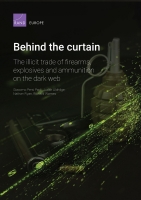PDF file 2.9 MB
Research Questions
• What is the size and scope of the trade in firearms and related products on the dark web?
• What is the potential impact of dark web enabled arms trafficking on the overall arms black market?
• What are the potential implications of dark web enabled arms trafficking for law enforcement agencies and policy makers, at both national and international levels?
The potential role of the dark web in facilitating trade in firearms, ammunition and explosives has gained increased public attention following recent terrorist attacks in Europe. However, the hidden and obscure parts of the web are used also by criminals and other types of individuals to procure or sell a wide range of weapons and associated products through cryptomarkets and vendor shops.
While the use of these platforms as facilitators for illicit drug trade has been increasingly researched by a number of academics, little has been done to investigate the role of the dark web in relation to the illegal arms trade.
To address this gap, and with a view to supporting policy and decision makers, RAND Europe and the University of Manchester designed this research project to explore the worldwide illegal arms trade, with a focus on the role played by the dark web in fuelling and/or facilitating such trade. The research was funded by the UK Partnership for Conflict, Crime and Security Research (PaCCS) under the Transnational Organised Crime theme, which is led by the Economic and Social Research Council on behalf of the Partnership.
The overall aim of the study was to estimate the size and scope of the trade in firearms and related products on cryptomarkets, including the number of dark web markets listing firearms and related products and services for sale, and the range and type of firearms and related products advertised and sold on cryptomarkets.
Key Findings
The dark web is an enabler for the circulation of illegal weapons already on the black market, as well as a potential source of diversion for legally owned weapons.
The dark web is increasing the availability of better performing, more recent firearms for the same, or lower, price, than what would be available on the street on the black market.
The US appears to be the most common source country for arms that are for sale on the dark web. Almost 60 per cent of the firearms listings are associated with products that originate from the US. However, Europe represents the largest market for arms trade on the dark web, generating revenues that are around five times higher than the US.
Firearms listings (42 per cent) were the most common listings on the dark web, followed by arms-related digital products (27 per cent) and others, including ammunition (22 per cent).
The dark web has the potential to become the platform of choice for individuals (e.g. lone-wolves terrorists) or small groups (e.g. gangs) to obtain weapons and ammunition behind the anonymity curtain provided by the dark web. In addition, the dark web could be used by vulnerable and fixated individuals to purchase firearms.
The illegal arms trade presents further challenges for law enforcement agencies and national governments. These challenges largely derive from the anonymity of individuals that use the dark web to purchase arms.
Recommendations
Policy makers and law enforcement agencies will be required to adapt intervention strategies, ensure that proper regulatory frameworks are in place, ensure that adequate resources are made available and ensure that specialist skills are developed.
Traditional policing and investigative techniques will remain vital. These include traditional firearms control measures designed to tackle illicit trafficking, such as efficient marking and record keeping, international cooperation for tracing, and good stockpile management.
Existing international instruments for combating arms trafficking should not be considered obsolete. The emergence of a new threat does not necessarily require the creation of new instruments.

No comments:
Post a Comment